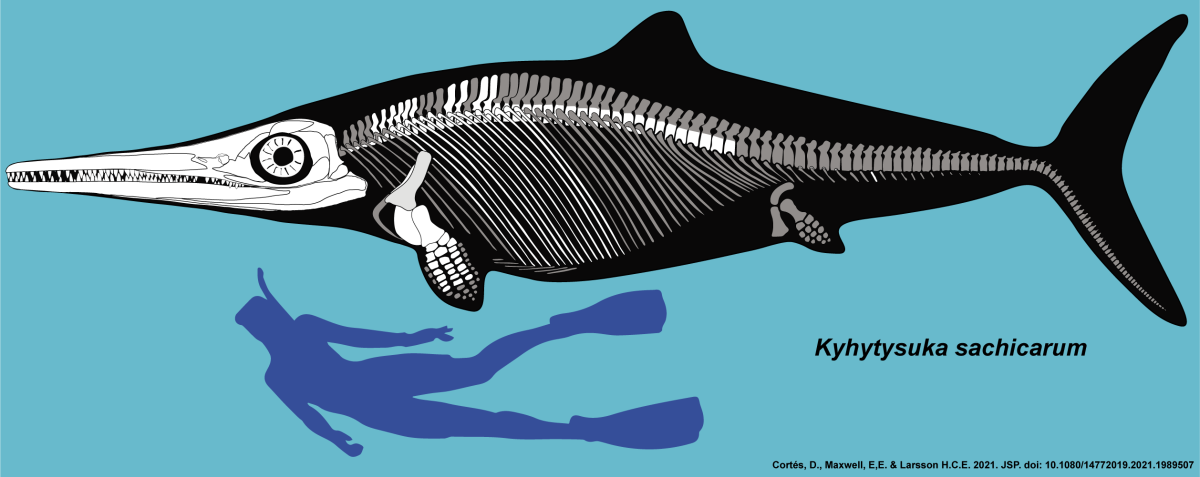Extinct swordfish-shaped marine reptile discovered
A team of international researchers from Canada, Colombia, and Germany has discovered a new marine reptile. The specimen, a stunningly preserved metre-long skull, is one of the last surviving ichthyosaurs – ancient animals that look eerily like living swordfish.
“This animal evolved a unique dentition that allowed it to eat large prey,” says Hans Larsson, Director of the Redpath Museum at McGill University. “Whereas other ichthyosaurs had small, equally sized teeth for feeding on small prey, this new species modified its tooth sizes and spacing to build an arsenal of teeth for dispatching large prey, like big fishes and other marine reptiles.”
“We decided to name it Kyhytysuka which translates to ‘the one that cuts with something sharp’ in an indigenous language from the region in central Colombia where the fossil was found, to honour the ancient Muisca culture that existed there for millennia,” says Dirley Cortés, a graduate student under the supervision of Hans Larsson and Carlos Jaramillo of the Smithsonian Tropical Research Institute.

Life reconstructions of Kyhytysuka sachicarum from the Early Cretaceous of Colombia. Credit: Dirley Cortés
The big picture of ichthyosaur evolution is clarified with this new species, the researchers say. “We compared this animal to other Jurassic and Cretaceous ichthyosaurs and were able to define a new type of ichthyosaurs”, says Erin Maxwell of the State Natural History Museum of Stuttgart (a former graduate student of Hans Larsson’s lab at McGill). “This shakes up the evolutionary tree of ichthyosaurs and lets us test new ideas of how they evolved.”

Dirley Cortés working with the skull of Kyhytysuka. Credit: Dirley Cortés
According to the researchers, this species comes from an important transitional time during the Early Cretaceous period. At this time, the Earth was coming out of a relatively cool period, had rising sea levels, and the supercontinent Pangea was splitting into northern and southern landmasses. There was also a global extinction event at the end of the Jurassic that changed marine and terrestrial ecosystems. “Many classic Jurassic marine ecosystems of deep-water feeding ichthyosaurs, short-necked plesiosaurs, and marine-adapted crocodiles were succeeded by new lineages of long-necked plesiosaurs, sea turtles, large marine lizards called mosasaurs, and now this monster ichthyosaur” says Dirley Cortés.

Skeleton of Kyhytysuka compared to a human for scale. Known bones are in white. Credit: Dirley Cortés
“We are discovering many new species in the rocks this new ichthyosaur comes from. We are testing the idea that this region and time in Colombia was an ancient biodiversity hotspot and are using the fossils to better understand the evolution of marine ecosystems during this transitional time,” she adds. As next steps the researchers are continuing to explore the wealth of new fossils housed in the Centro de Investigaciones Paleontológicas of Villa de Leyva in Colombia. “This is where I grew up,” says Cortés “and it is so rewarding to get to do research here too.”
Video of Kyhytysuka dinosaur animation
3D animation of Kyhytysuka. Credit: Dirley Cortés
|
About this study “Reappearance of hypercarnivore ichthyosaurs in the Cretaceous with differentiated dentition: revision of ‘Platypterygius’ sachicarum (Reptilia: Ichthyosauria, Ophthalmosauridae) of Colombia” by Dirley Cortés, Erin E. Maxwell, and Hans C. E. Larsson is published in the Journal of Systematic Palaeontology. |
About McGill University
Founded in Montreal, Quebec, in 1821, McGill University is Canada’s top ranked medical doctoral university. McGill is consistently ranked as one of the top universities, both nationally and internationally. It is a world-renowned institution of higher learning with research activities spanning three campuses, 11 faculties, 13 professional schools, 300 programs of study and over 40,000 students, including more than 10,200 graduate students. McGill attracts students from over 150 countries around the world, its 12,800 international students making up 31% of the student body. Over half of McGill students claim a first language other than English, including approximately 19% of our students who say French is their mother tongue.






